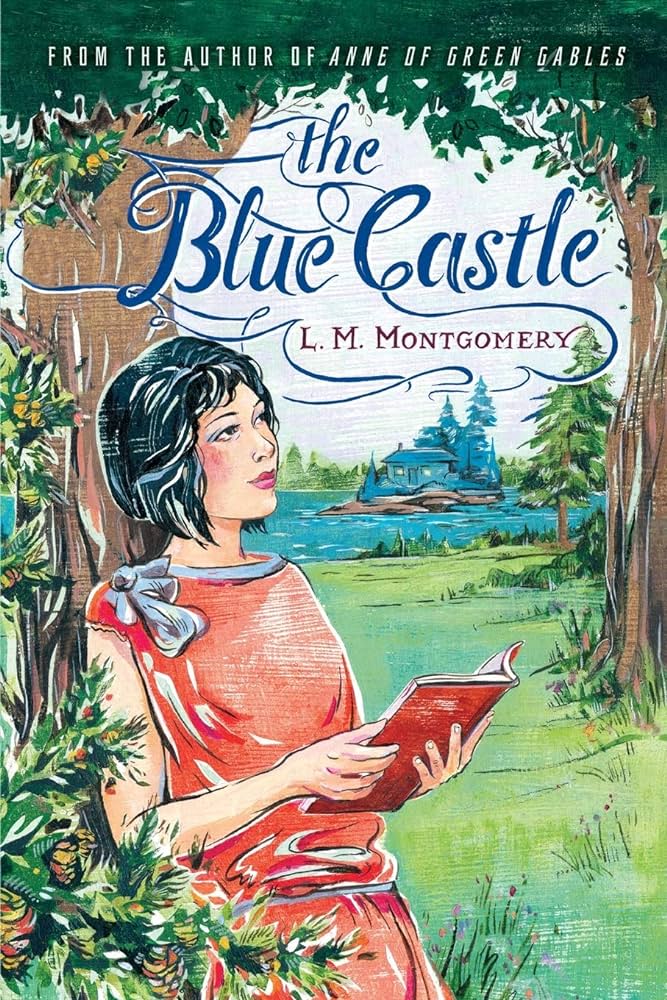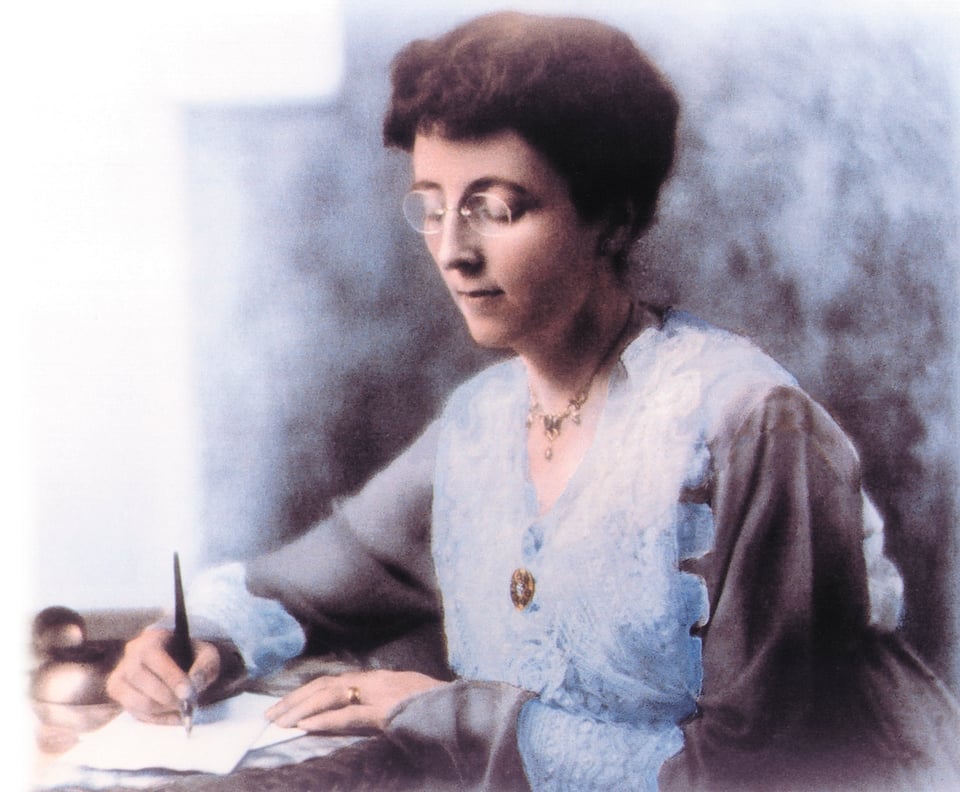Issue #1: The Blue Castle
A hidden family dynamic revealed in a classic romance novel

Book Review
The Blue Castle by L.M. Montgomery
This book inspired me with the following:
Knowing someone and seeing someone are two very different things.
And
Those who have known you the longest might not be those who SEE you the best.
Audio version: Kate reads this article to you!
Book information and ratings:
The Blue Castle | by L.M. Montgomery, 1926 | |
Genre: | Fiction |
|
Subject: | Self-discovery, Identity, Romance | |
Rating: | Worth the read | |
Read as: | Print copy | |
Readability: | Accessible | |
Subject Weight: | Light | |
How I found this book:
Two years ago, a friend invited me to Kat’s book club, and it was life changing. This book club rekindled my love of literature and gave me a safe, encouraging place to open up and share my opinions and insights. I am deeply committed to our monthly meetings, and the women who attend are some of my favorite people!
The Blue Castle was one of the first books I read for this book club. That meeting was the first time I shared my quick little insight–and everything paused as Kat stared at me in her astonished, bewildered, blue-eyed way, like I said the most world-altering thing…which, for her, it was.
So, in case you’re thinking of skipping the rest of this review because you aren’t interested in a romance novel from the 1920s written by the author of Anne of Green Gables, I encourage you to read on. Even if you don’t think you will pick up this book, there are some interesting family dynamics at play in this story, and I will share one in particular that broke Kat’s world open and that I refer to often.
About this book:
[Valancy Stirling] was twenty-nine, lonely, undesired, ill-favored–the only homely girl in a handsome clan, with no past and no future. (p 5)
The author does a tremendous job of illustrating the specific, horrid little box that is Valancy’s life: her domineering mother, her demanding aunt, her bullying uncle–and her overly-doted-on, beautiful, shiny cousin. Her individuality is denied at every turn: from the rug in her room, to how she styles her hair, to the predictable and insensitive jokes, to the childish nickname she cannot escape. Molded by her family’s culture to exist in resigned compliance and servitude, she is cemented in her place–a strange and unfortunate little creature trapped by tradition and convention.
Most of us rebel at some point and in some way from family tradition, but it’s usually a gradual growing-up process. For Valancy, it happened all at once. The stark contrast–shifting from a wilting, cowering girl into an outspoken, mischievous little imp–was enormously satisfying and absolutely hilarious. I was giddy and gleeful at her behavior and at her family's reaction!
I’ll leave you to imagine (or find out for yourself) what would cause her to bust the mold and leave the pieces trailing behind her as she leaves home to do exactly what she wants for the first time in her life, which is…
…to leave her respectable family and move to the outskirts of town, taking a job as a housekeeper for the town drunk and his dying daughter.
****
Everyone in town knew Roaring Abel: a fierce Presbyterian and a drunk. But, he was a harmless drunk–a man in pain. Cissy Gay was his only child. She and Valancy had been friends at school.
Cissy was also a social outcast, not only because of her father’s drunken behavior, but because she had an illegitimate child. “The baby had lived for a year. After its death, Cissy faded away. Two years ago Dr. Marsh had given her only six months to live–her lungs were hopelessly diseased” (p 85).
With his daughter’s sickness and his alcohol habits, Roaring Abel was having a hell of a time hiring a housekeeper. Valancy happened to hear about the situation:
[She] hardly noticed the profanity. Her attention was focused on the horrible thought of poor, unhappy, disgraced little Cissy Gay, ill and helpless in that forlorn old house out on the Mistawis Road, without a soul to help or comfort her. And this in a nominally Christian community in the year of grace nineteen and some odd! (p 86)
“Heart wrung” for Cissy (and seeing a way out of her mother’s house), she offers to take the position.
“Oh!” Cissy put her thin arms around Valancy’s neck. “Oh–will you? It’s been so–lonely. I can wait on myself–but it’s been so lonely. It would be just like–heaven–to have someone here–like you. You were always–sweet to me–long ago. (p 95)
These two young women build a sweet and intimate relationship, each nurturing the other. Additionally, this taste of freedom: earning her own money, doing her job as she liked, dressing how she wanted, and finding purpose and meaning in caring for Cissy Gay, brings Valancy to full color.
Inevitably, Cissy passes away. In her grief, Valancy also has to say goodbye to her job–as a single woman, she wasn’t comfortable staying alone with a man who was not family by blood or marriage.
After the funeral, her family expects her to return home.
“We will just treat her as if nothing had happened when she comes back,” decreed Uncle Benjamin. “That will be the best plan. Just as if nothing had happened.” (p 141)
And, at THAT prospect, Valancy does not return home, but finds another unexpected niche for herself. As she’s saying goodbye to Roaring Abel, ready to move on to her new place, he says:
“[...] Well, I’m obliged to you. You helped me out of a bad hole and I won’t forget it. And I won’t forget what you did for Cissy. I’m your friend, and if you ever want any of the Stirlings spanked and sot in a corner send for me. [...] You’re the best small sport in the world, and your little finger is worth the whole Stirling clan tied together.” (p 142-3)
****
The author spends another 100 pages developing the romantic relationship and Valancy’s self-discovery. And I don’t suppose this little morsel of the story is anything unusual–but what struck me was the quality of the relationships Valancy built with Abel and Cissy in such a short amount of time.
I loved the relationship between the two girls, but I really loved that Abel–with all of his self-admitted faults and all the differences in age, gender, social status, and life experience–really valued her. Yes, for what she had done, but also for who she was. As they parted ways, he expressed true friendship. Valancy had shown up in the most authentic way possible, and he saw her…and her family would never see her that way–or couldn’t.
****
That night at book club, I was just ending this little thought when Kat whirled around in her seat and fixed me with her gigantic stare.
****
I think most of us believe that the people closest to us know us best. Surely those who endured the growing phases, put up with the best and worst of us, and are still around should be the ones we trust–the ones we build our self image on–because they have seen it ALL.
But, a closed family system works to self-preserve by keeping everyone functioning in their assigned role. Montgomery clearly defined that system with Valancy in the Sterling family. Changing the pattern in any way was a threat–her happiness and individuality didn’t matter, they just wanted her to go back and do what she was supposed to do!
In daily or family relationships, it’s just too easy to be valued for your function–too easy to become the expected fixture–too easy to be taken for granted as the facilitator of this or that–and to not be “seen,” unless you’re falling short. It’s also worth considering what a family or family member might have to lose by seeing you differently. So, if we spend our lives believing only the reflection that type of family system flings back at us, we might not go very far–or anywhere. Ever.
****
This idea hit Kat straight-on, because she was in a place of frustration: a family member refused to see her and connect with her no matter how well or how often she showed up for them. This helped her consider that: yes, it was infuriating that they didn’t see her–but maybe they couldn’t see her. Maybe they simply could not pay the price to see her as the uniquely gifted person she was. (And that is truly their loss.) So, maybe she could let that expectation go, at least a little bit.
This struck me, because I was coming from a place of discovery. I was building new friendships with lovely, sincere people who valued and saw me differently than my family did. I was stunned. My family’s views about me, built on a long and intimate history, had to be true…I can’t just rewrite my self-image!…these new people don’t really know me…but, maybe they SEE me.
That is a beautiful thing to consider.
****
From here, we could further discuss open versus closed family systems. We could self reflect on our participation in harmful behavior patterns and how to break out of them. We could consider ways we can work towards seeing our family members more clearly–how can we give them space to be their best selves? What price might we have to pay? We could also talk about our brain’s biological programming to shortcut any new information to fit into what is familiar and safe–and how (or can) we counteract that? We could examine why our society overemphasizes romantic and familial relationships while underrating platonic friendships–and is that healthy, helpful, or true for you? Why? We could also pivot to a new subject and talk about how Valancy following her heart-desires and serving both herself and Cissy is the definition of true generosity…but, we can discuss those topics another time.
I want to leave you with this mutual moment of clarity for me and Kat, that:
Knowing someone and seeing someone are two very different things.
And
Those who have known you the longest might not be those who SEE you the best.
****
Fair warning: if you do read this book, the ending is….well….it made Sheri swearingly mad! So, I’ll say this:
Montgomery builds this fantastic banana split right in front of your eyes: a glass, boat-shaped dish; a perfectly ripe banana, sliced long-ways; three cold-scooped ice cream piles; warm fudge, drizzled and sliding all over; a generous sprinkling of nuts; large puffs of whipped cream…AND five bright red cherries.
AND colorful sprinkles.
AND ten birthday candles.
AND THEN, she tops it off with a fizzling, blinding, 4th of July SPARKLER!
Yes, it’s a bit much. But, the experience was colorful and sweet. Dig in, if you like!
About the author:
LUCY MAUDE MONTGOMERY (November 30, 1874–April 24, 1942), better known as L. M. Montgomery, was a Canadian author. Her most famous work by far is the Anne of Green Gables series, set in a small town on Prince Edward Island in the late 19th and early 20th centuries. Montgomery’s work made her a Canadian pop culture icon, as well as a beloved author around the world. thoughtco.com
Sources:
Montgomery, L.M. The Blue Castle. 1926. Sourcebooks Inc., 2011, USA.
*This is issue #1 of The Book Moth Newsletter


-
Beautiful writing and insightful! Can’t wait to read this book!
-
You're so brilliant. What a breath of fresh air to read your eloquent well written thoughts on this book! Thank you.
Add a comment: